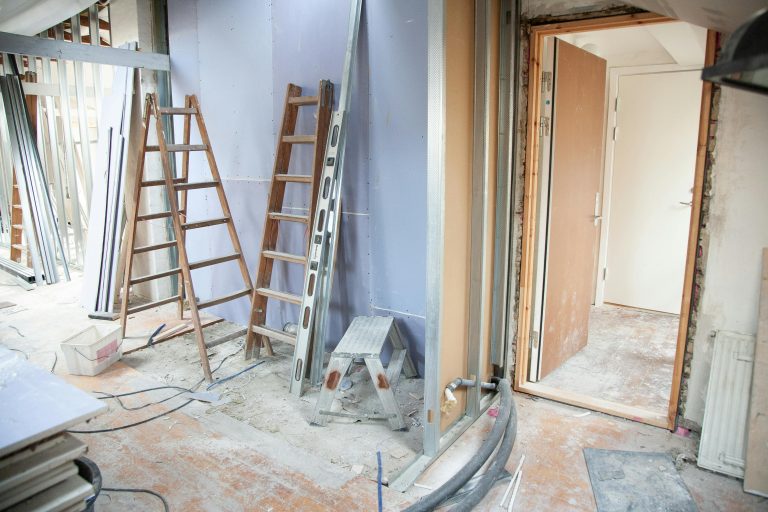Planning a home renovation is an exciting yet nerve-wracking process. While drawing out floor plans and choosing paint colors, it’s only natural to focus on what can be seen. However, don’t be deceived by appearances, as often the magic of a renovation truly lies beneath the surface. Hidden home upgrades can make a world of difference for your space in terms of comfort, efficiency, and, of course, value.
From insulation and plumbing to wiring and ventilation, investing in often-overlooked details and components can have a significant impact on your experience as a homeowner. Not only do these invisible upgrades add value immediately, but they also offer peace of mind and long-term savings.
So, before you dive into picking countertops and wall art, consider this guide on hidden home upgrades to help you make the most of your home renovation.
The Importance of Hidden Home Upgrades
When the time comes to design or redesign your living space, it’s understandable if your head goes straight to visible changes and eye-catching upgrades. After all, they’re the ones that make a statement. However, when it comes to a return on investment and overall quality, the unseen elements matter a great deal.
Hidden home upgrades matter for a variety of reasons. First and foremost, they have a big role in the home’s efficiency and the everyday life of its residents. Soundproof underlays, quiet-close fixtures, and high-quality ventilation systems are all essential for long-term comfort. By investing in these usually invisible elements, you transform your living space into a space that breathes and caters to all your needs in subtle ways.
Structural components like insulation and wiring are another area to consider during home renovation. They not only ensure the house stands strong for years to come, but also guarantee optimal safety and security.
Hidden home upgrades may not seem like a priority at first, but when you think about it, how often do you see or hear someone mention the quality of their home’s insulation? Energy-efficient windows, a better thermostat, or quality ventilation system? These aspects of a living space may not seem exciting at first, but in reality, they make a difference between a welcoming, energy-efficient home and one that is always a few degrees too hot or too cold.
Investing in hidden home upgrades guarantees value for money. They are improvements you will thank yourself for later and will give your living space an edge when it comes to resale value. While you might not be in a rush to sell, these invisible home upgrades are worth a second thought for both their immediate and potential long-term benefits.
Long-Term Value of Smart Investments
Hidden home upgrades might sound like a secret ingredient to a long-lasting return on investment (ROI) and a recipe for future savings, but are they really all they are cracked up to be? Let’s take a closer look at how certain out-of-sight elements can help you save money and energy in the long term.
Insulation
Insulation is often a go-to upgrade for home renovation experts and do-it-yourself renovators alike. The main reason is simple: improved insulation leads to energy savings. If your home is properly insulated, your heating and cooling systems will have to work less hard to keep your house comfortable. This saves you money on utility bills in the long run and ensures optimal energy efficiency.
A related area of home improvement is ventilation. By choosing quality, energy-efficient ventilation systems, you allow your home to ‘breathe’ and improve air quality. This is especially important for those living in cities with poor air quality, but the benefits of upgraded ventilation are universal.
Smart Thermostats
Smart home technology is all the rage these days and the average home is getting smarter by the day. A connected thermostat or HVAC system is a clever choice as it can automate temperature regulation and improve energy efficiency.
When you consider how much time we spend at home, it’s a no-brainer to invest in something that not only makes your living space smarter but actually learns from your everyday routine and helps reduce utility bills.
Plumbing
Plumbing might not be a first thought when it comes to home renovation, but it should be. By improving your home’s plumbing system, you reduce the risk of leaky pipes and water damage, both of which can be extremely expensive to deal with. High-efficiency fixtures can also contribute to significant savings on water bills.
Invisible Structural Components
Few elements of home renovation are as vital and long-lasting as its structural components. By ensuring a house has a solid foundation and well-built walls, ceilings, and floors, you set the stage for all the visible and invisible elements that follow. From safety and security to preventing drafts, solid structural elements are a prerequisite for a top-notch home improvement project.
Electricity
An often-overlooked area of home renovation is the electrical system.While it might be tempting to let the electrician decide on the wiring, there are a couple of things you should consider in order to make your house as energy-efficient and future-proof as possible.
Investing in a system that can support your everyday needs as well as a connected home is essential in today’s technological climate. An electrician might not be your most interesting conversationalist, but their job is of the utmost importance for any home renovation and upgrade project.
Energy Efficiency: Smart Thermostats and More
For homeowners with a budget, it can be easy to get lost in all the creative details of a home renovation, forgetting that there are certain elements that will bring more value than others. Energy efficiency is one such area of home improvement that can cut future costs in utility bills and have an immediate effect on the home’s ROI.
Smart thermostats
Smart thermostats have all but become a standard part of today’s connected home. From remote control of temperature to learning from everyday routine and adjusting to weather conditions, they can add substantial savings to your home’s energy efficiency.
Smart home sensors can further improve this by measuring not only the room temperature but also occupancy. Paired with automation systems, these clever devices can make your home not only more energy-efficient but actually save energy by turning off your heating or cooling when the room is unoccupied.
Windows and insulation
Windows are often a favorite when it comes to home renovation, but have you ever stopped to think about how efficient they actually are? Energy-efficient windows retain heat during the colder months and cool air during the summer, making it easier on your HVAC system.
Additionally, pay attention to the windows’ glazing. Double-glazed or even triple-glazed windows are more expensive to buy but provide superior insulation and pay for themselves quickly. You can also dress the windows with sliding sash solutions, to increase insulation.
In addition to windows, other areas of insulation can be improved to optimize your home’s energy efficiency. Attic and wall insulation are two areas that will directly reduce drafts and save on utility bills.
Lighting and automation
Switching to LED lighting is one of the easiest ways to improve energy efficiency at home. LEDs not only use a fraction of the electricity of incandescent bulbs, but they also last a lot longer.
Energy-saving automated lighting systems are another aspect to consider during home renovation. Motion sensors and automation can help cut energy waste by switching lights off in unoccupied rooms. Automated lighting also works beautifully with other smart home technology, such as connected doorbells, speakers, and entertainment systems.
Why Quiet-Close Fixtures Matter
Installing new cabinets and furniture fixtures is an exciting part of home renovation. However, once they are in place, it’s often easy to forget they even have hinges until they make a racket every time they’re opened or closed.
Noise can be one of the most pervasive and unpleasant problems, especially in city living. Fortunately, noise-proofing your home is one of the simplest and most effective ways to improve everyday life.
Quiet-close hardware
Replacing your old hinges with specially designed quiet-close hardware will make a noticeable difference in noise levels in your home. A home renovation is an ideal time to make this otherwise simple and invisible upgrade that will change your household for the better. The good news is that they are easy to find and install and are available in an array of styles.
Acoustic underlays
Installing acoustic underlays—like those offered by QA Flooring—is an equally simple solution with immediate results for soundproofing your home. Used often in commercial buildings, acoustic underlays help absorb the noise and are great for a multi-unit residential environment.
Installing them under carpet or any other floor covering is easy to do as a DIY project or a professional one. The underlays not only have a positive effect on noise levels, but on heat retention as well. It’s a small change that will not only cut down on noise, but one you will barely notice in your everyday routine.
Noise can be extremely disruptive and make home feel less peaceful.Silent-close hardware and acoustic underlays are two improvements that will have an instant effect, and once they are in place, you will notice how much better your home feels.
Hidden Home Improvement Tips
While choosing color schemes and installing new fixtures are easy and fun parts of home renovation, small improvements that make the biggest difference are often the ones that are the most easily overlooked. From choosing modern handles to optimizing insulation and ventilation, let’s consider several tips that can have an immediate and positive effect on the comfort of your home.
Efficiency and insulation
Insulation and efficiency upgrades don’t have to be an afterthought or something you only do when you are renovating your home. While it’s always easier to change and update when there’s work going on, there are simple ways to make your home more energy-efficient without breaking the bank or a sweat.
Check your seals and drafts
Drafts and unsealed windows and doors are a leading cause of energy inefficiency in homes. Checking for leaks and any gaps that need sealing is a simple DIY project and one that will cut energy bills almost immediately.
Draft excluders and seals are easy to find and install and can make a huge difference to drafts and noise pollution. Sealing areas that might be more out of sight, such as skirting boards and window sills or attic hatches, can have a surprisingly large effect.
Upgrade fixtures
A simple and often-overlooked solution for a quieter and more energy-efficient home is upgrading existing fixtures to quieter-close alternatives.These are especially useful in shared households where noise can become an immediate issue in busy schedules.
You can find them in a variety of different styles and they are easy to install on existing furniture and cabinets. You can further improve your home’s soundproofing by installing acoustic underlays, which are available for carpets, floorboards, and other types of flooring.
Hidden Home Improvement Projects with Immediate Benefits
Hidden home improvements can offer value in a variety of areas. While all of the tips and upgrades mentioned in this article have their place in a home renovation project, there are a few areas that often require a professional hand. Structural elements of a house as well as its energy efficiency and security are all important areas that often get overlooked, but which are important to the overall quality and safety of a house.
Insulation and energy efficiency
Insulation and energy efficiency are often one of the first steps toward improvement when it comes to a home renovation project. There is no better time to assess all elements of a home’s structural components, from insulation and ventilation to windows and walls.
Electricity and wiring
Another area often in need of renovation or upgrade is the home’s electrical system. From adding support for smart home technology to rewiring and ensuring that the system is up to code, electricity is an often overlooked area of a house in need of a professional hand.
Security
Home security is an important element to assess when planning home renovation or home improvement. A home alarm or smart security system may not be the most thrilling part of renovating your space, but it is one of the most important for your home’s safety and security. There are plenty of smart options to choose from and security companies often have a range of packages that can be tailored to meet specific needs.
Hidden home improvements are an area of home renovation and design that is often overlooked. They may not have the pizazz of eye-catching colors and finishes but are an important and often essential area of home improvement.
If you pay close attention to the home renovation details that often get out of sight, literally, you’ll be rewarded with a more energy-efficient and comfortable living space.
Conclusion
From underlays and ventilation to smart thermostats and automated lighting, it’s often these things that can make a home feel like a sanctuary. They work behind the scenes to make life more comfortable for residents, reduce noise and pollution, and use less energy. Hidden home improvements are an important part of renovation and upgrading, and one that should be included in every home renovation project.
While they may not make the biggest splash when it comes to design, hidden home improvements will affect you and your family in a big way.As such, before you get carried away with surface-level decisions such as color schemes and choices of fixtures, make sure you take a closer look at the parts that will have a greater, long-term effect.
Home renovation and improvement projects are the perfect time to have a more critical eye when it comes to your living space. By assessing often overlooked areas and making upgrades where needed, you set your home up for long-term comfort and efficiency. Hidden home improvements may not always be the most exciting part of renovation and design, but they can make all the difference.


